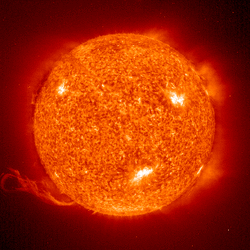the sun

Our Sun is our closest star to our Earth. It is at least 4.5 billion years old. Without the Sun, the Earth would not be able to support life.
How does the Sun work?
The Sun stays lit by converting hydrogen into helium like a big atomic furnace. As a result, tremendous amount of energy is released.
Scientists can only be study the sun from spacecraft above our atmosphere because the Earth's atmosphere absorbs X-rays and solar X-rays. Such spacecraft include SOHO ( ESA's Solar and Heliospheric Observatory) and Ulysses.
Why is it important?
The Sun is important because it provides the Earth heat, it creates our daylight by emiting electromagnetic radiation, it allows plants to grow via photosynthesis which in turn absorb carbon dioxide and create oxygen. It is one of the prime ingredidents for most Earth life-forms.
There are exeptions such as an lifeforms which have been found near ultra-hot underwater volcanic vents.
Facts about Our Sun
* The Sun's temperature: 10,000 degrees Fahrenheit at the surface and 27,000,000 degrees Fahrenheit at the center.
* Distance from Earth: 149 million Kms
* The Sun's composition: 70% hydrogen, 28% helium, 1.5% carbon, nitrogen, and oxygen, and 0.5% all other elements.
* Size: 870,000 miles in diameter, 109 times larger than the Earth's.
* Average Distance from the Earth: 93,000,000 miles. It takes light 8 and 1/2 minutes to travel from the Sun to the Earth.
Sun's Composition:
The Sun is consists of six parts:
1. The Core is the centre. This is where hydrogen is converted into helium.
2. The Radiation Zone is above the core.
3. The Convection Zone is the outer part of the Sun's interior.
4. The photosphere is above the convection zone and is the part of the Sun that we see.
5. The chromosphere isabove the photosphere. During solar eclipses it can be seen when the much brighter photosphere is blocked out by the Moon.
6. The Corona is the outermost layer of the Sun. It is the hottest part of the surface of the Sun. It extends millions of kilometers into space and is a million times fainter than the photosphere. It has temperatures reaching millions of degrees. The corona can be seen only during solar eclipses because it is millions of times fainter than the photosphere. Specially designed scientific instruments called coronagraphs can also observe it.
How does the Sun work?
The Sun stays lit by converting hydrogen into helium like a big atomic furnace. As a result, tremendous amount of energy is released.
Scientists can only be study the sun from spacecraft above our atmosphere because the Earth's atmosphere absorbs X-rays and solar X-rays. Such spacecraft include SOHO ( ESA's Solar and Heliospheric Observatory) and Ulysses.
Why is it important?
The Sun is important because it provides the Earth heat, it creates our daylight by emiting electromagnetic radiation, it allows plants to grow via photosynthesis which in turn absorb carbon dioxide and create oxygen. It is one of the prime ingredidents for most Earth life-forms.
There are exeptions such as an lifeforms which have been found near ultra-hot underwater volcanic vents.
Facts about Our Sun
* The Sun's temperature: 10,000 degrees Fahrenheit at the surface and 27,000,000 degrees Fahrenheit at the center.
* Distance from Earth: 149 million Kms
* The Sun's composition: 70% hydrogen, 28% helium, 1.5% carbon, nitrogen, and oxygen, and 0.5% all other elements.
* Size: 870,000 miles in diameter, 109 times larger than the Earth's.
* Average Distance from the Earth: 93,000,000 miles. It takes light 8 and 1/2 minutes to travel from the Sun to the Earth.
Sun's Composition:
The Sun is consists of six parts:
1. The Core is the centre. This is where hydrogen is converted into helium.
2. The Radiation Zone is above the core.
3. The Convection Zone is the outer part of the Sun's interior.
4. The photosphere is above the convection zone and is the part of the Sun that we see.
5. The chromosphere isabove the photosphere. During solar eclipses it can be seen when the much brighter photosphere is blocked out by the Moon.
6. The Corona is the outermost layer of the Sun. It is the hottest part of the surface of the Sun. It extends millions of kilometers into space and is a million times fainter than the photosphere. It has temperatures reaching millions of degrees. The corona can be seen only during solar eclipses because it is millions of times fainter than the photosphere. Specially designed scientific instruments called coronagraphs can also observe it.
